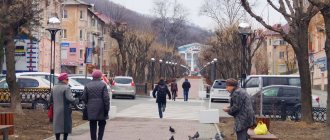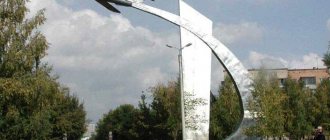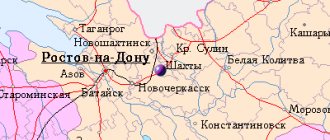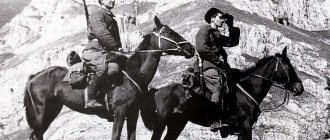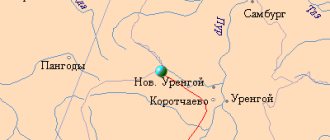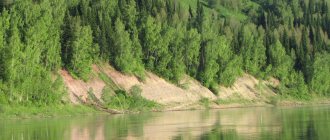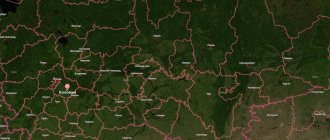General information and history of Nefteyugansk
If we proceed from the name of this town, saturated with black wealth, then this story should begin like this: in the three-ninth kingdom, in the three-ninth state, the Nefteyugans lived without grieving and made a living with money... But it will begin more obviously and truthfully.
In the heart of the Khanty-Mansiysk Autonomous Okrug, on the banks of the Yuganskaya Ob channel, among the swamps, on the island for 46 years there has been a city that was originally a village of geologists. Often and with pathos, local officials and cultural figures say: “the history of our city is written in oil.” It is perhaps impossible to disagree with this: after all, the only reason why the young, energetic and courageous ancestors of the Nefteyugans decided to settle here was the black emulsion.
Old photo of Nefteyugansk
So, on December 18, 1962, a fountain erupted from well R-63 with a daily oil flow of 800 tons. And then things started to happen - they learned about the small village not only in the Tyumen region, but throughout the USSR. And the helicopters flew, active water communication began.
Modern Nefteyugansk. Photo by Pavel Girin
The first romantics came here for only three years, thinking of earning money and returning to their homeland. Frankly, even now, most visitors think the same thing. But it’s not for nothing that Nefteyugansk grew up in a swamp - the small, quiet northern city became the second home for most of those Komsomol members, strong families were built here and their children and grandchildren were born. The calm and measured life on the island sucked them in.
Subsections
- home
- City
In the chronological table, select the year you are interested in
1961
| 1962 | 1963 | 1964 | 1965 | 1966 | 1967 | 1968 | 1969 | 1970 | |
| 1971 | 1972 | 1973 | 1974 | 1975 | 1976 | 1977 | 1978 | 1979 | 1980 |
| 1981 | 1982 | 1983 | 1984 | 1985 | 1986 | 1987 | 1988 | 1989 | 1990 |
| 1991 | 1992 | 1993 | 1994 | 1995 | 1996 | 1997 | 1998 | 1999 | 2000 |
| 2001 | 2002 | 2003 | 2004 | 2005 | 2006 | 2007 | 2008 | 2009 | 2010 |
| 2011 | 2012 | 2013 | 2014 | 2015 | 2016 | 2017 | 2018 | 2019 | 2020 |
Informational historical background about the city of Nefteyugansk
In June 1961, a detachment of geological prospectors with a team of carpenters landed on the banks of the Yugansk Ob, 2 kilometers from the village of Ust-Balyk. They laid out the first street of a new workers' settlement. One after another, throughout the summer, barges with new settlers approached the shore. The houses of future new residents were built at a rapid pace, and they themselves carried out the interior decoration. It was necessary to prepare a base for the expedition during the short northern summer. Geological exploration work was carried out in the Ust-Balykskaya area, which was then renamed Partsezdovskaya - in honor of the XXII Congress of the CPSU, but this name was not fixed. After just a year and a half, the documents again mention the Ust-Balyk area - the future oil field that gave life to our city. The workers' settlement itself was given the name Nefteyugansk in 1962. It combined two concepts - oil and the Yuganskaya Ob River, on the banks of which a new settlement was rapidly growing. On October 15, 1961, the first oil gusher struck from the R-62 well, and on December 18, 1962, the R-63 well gushed with a daily oil flow of 800 tons. There have never been such large fountains in the Tyumen region. On May 26, 1964, the first commercial oil from the Ust-Balyk field was sent to the oil refinery in the tanks of an oil barge. The industry of Siberia began to work on its own raw materials and from this moment the oil production industry of the Nefteyugansk region begins to count. On October 16, 1967, the Presidium of the Supreme Council of the RSFSR issued a Decree “On the transformation of the workers’ village of Nefteyugansk, Surgut region, Khanty-Mansiysk National District, Tyumen Region, into a city of district subordination.” In January 1968, the city of Nefteyugansk welcomed a special guest - member of the Politburo of the CPSU Central Committee, Chairman of the Council of Ministers of the USSR Alexei Nikolaevich Kosygin. At the end of the 1960s, the first stone houses were built, the construction of the Yunost recreation center and the Yugan cinema began. Construction of a giant oil pipeline began: Samotlor - Ust-Balyk - Tyumen - Ufa - Almetyevsk. In 1980, the Nefteyugansk district was formed with its center in the city of Nefteyugansk. The city of Nefteyugansk is located on an island between two rivers. On November 3, 1984, a bridge with a length of 870 meters was opened across the Yuganskaya Ob channel. In 2007, a new bridge was put into operation, its length is 874 meters. These engineering structures solved the transport problem of communication with the Mainland. On September 15, 1977, an Order was issued on the creation of the Yuganskneftegaz Production Association, which later became owned by the Yukos Oil Company, and after the auction on December 19, 2004, the enterprise became the property of the oil company. Today LLC RN-Yuganskneftegaz is the main production division, which accounts for 57% of production. In 1982, a public museum was created, which, having gone through a long path of development, today acquired the status of the Nefteyugansk city municipal autonomous cultural institution "Historical and Art Museum Complex". Since 1989, the local television studio "Intelcom", the city municipal television and radio company, has been broadcasting. Today, city television news is broadcast by the Yugansk television and radio campaign. On October 19, 1997, the first parishioners were received by the Holy Spirit Church. In 2001, a stele to the ataman of the Siberian Cossack army Ermak was erected on the territory of the temple. At the same time, construction of a Muslim mosque was underway. On June 26, 1998, the head of the city, Vladimir Arkadyevich Petukhov, was killed (see the YUKOS case). On house No. 17 in the 13th microdistrict there is a memorial plaque dedicated to V.A. Petukhov. In 2013, the name of Vladimir Arkadyevich was immortalized in the name of the street, and in 2014, a monument to V.A. was erected in the city center. Petukhov. In 2000, the number of city residents crossed the 100,000 mark, making it the largest city in the district (along with Surgut and Nizhnevartovsk). On October 14, 2005, a memorial plaque dedicated to the first general director, Roman Ivanovich Kuzovatkin, was installed on the office building of Yuganskneftegaz LLC. On February 10, 2010, a cultural exhibition dedicated to the history of oil and gas development and the formation of the city of Nefteyugansk was opened. On October 14, 2011, on the initiative of the public organization “Society of Old-Timers of the City of Nefteyugansk” and with the assistance of LLC “RN-Yuganskneftegaz”, another industrial development monument “Well R-62 - the discoverer of the Ust-Balyk field” was opened at a historical site. On June 20, 2013, the All-Russian Council of Local Self-Government established the medal “For Loyalty to Duty and Russia” for mayors and heads of municipalities named after V.A. Petukhov. This annual award is presented to heads of municipalities who honestly and selflessly protect public and state interests and develop their cities and settlements. The first medal was posthumously awarded to Vladimir Arkadyevich himself; it was given to Petukhov’s widow, Farida Islamova. In 2013, the city library hosted a presentation of a collection of poems by the honored cultural figure of the Khanty-Mansi Autonomous Okrug - Ugra, Honorary Citizen of the city Evgeniy Petropavlovsky “Let’s talk to you, my city...”. The collection includes works already known and beloved by everyone, as well as previously unpublished materials. On June 26, 2014, a bust of Vladimir Arkadyevich Petukhov, the first popularly elected mayor of the city, was unveiled in the center of Nefteyugansk. The author of the memorial is sculptor Volodya Sargsyan. In November 2014, at a meeting of the Duma, Nikolai Efimovich Tsybulko was elected head of the city. Every year the “Ski Track of Russia” takes place in Nefteyugansk. 650 city residents from 6 to 60 years old take up skiing. Traditionally, amateurs of this sport, professional athletes and beginners take to the start line. Based on the results of the competition, the fastest ones are awarded with medals, cups and certificates. Regardless of nationality, in June, Nefteyugans take part in a mass holiday - Sabantuy. The cultural program of the holiday is always represented by performances by creative groups, amateur art competitions, sports competitions, including weight lifting, arm wrestling, bag fighting, and, of course, the national wrestling “Kuresh”, which attracts the largest number of participants and spectators. Another wonderful tradition of Nefteyugansk is the annual hand-to-hand combat competition, dedicated to the memory of Oleg Goering, a police major who died in 2006 while on duty in the North Caucasus region. The military search club “Dolg” is known far beyond the borders of Nefteyugansk. Club members annually make a significant contribution to perpetuating the names of fallen heroes of the Great Patriotic War. They not only find and participate in burying the remains of soldiers at battlefields, but also look for the relatives of these heroes. Thanks to the work of the “Duty” club, another monument to military glory appeared in Nefteyugansk - a 45-mm anti-tank combat gun. “Sorokapyatka”, that’s what the soldiers called this small weapon. In honor of the 70th anniversary of the Victory, the cannon was installed on a pedestal in Victory Park. In June 2021, Nefteyugansk became the base for the youth forum of the Ural Federal District “Morning-2016”, in which 1,500 people took part. The chronicle of the city’s labor achievements continues...
The certificate was prepared on the basis of documentary materials by employees of the NG MAUK "Museum Complex"
Climate and ecology of Nefteyugansk
Yes, Nefteyugansk is definitely a city for frost-resistant people! Winter here sometimes lasts 8 months a year: snow falls in October and melts extremely slowly, snowdrifts in the city can be seen even on the May holidays... Swift autumn, long spring and several hot weeks of summer. In winter, on average, thermometers range from −20 to −30 degrees Celsius. Summer is no longer predictable; from June to August it can be comfortable (+20) or maybe scorching hot (+33).
City administration building in winter
The environmental situation in the city is mainly dictated by cars - there are no other air pollutants in Nefteyugansk itself. The main industry in which the city lives is oil and gas production. Accordingly, these workshops cause damage to the environment, but there are only a couple of them near the city.
A sadder situation with water. More precisely with its cleaning. Visitors jokingly say that oil flows from the tap here. Local residents are no longer laughing. We’ve lost count of how many times the Nefteyugans were promised “clean water,” how many millions of rubles have flowed into unknown places, but there is still no treatment plant or replacement of pipelines. Therefore, one of the most important household items in apartments is a water filter.
Such water is not uncommon in the apartments of Nefteyugans
Population of Nefteyugansk
Despite the frosts and the distance from the center of Russia, there are consistently many people who want to join the ranks of Nefteyugans every year. Mostly graduates of oil universities and colleges go north to buy long rubles. To attract young specialists, the city-forming enterprise LLC RN-Yuganskneftegaz has developed support programs, for example, recently, all newly recruited oil workers receive rooms in a new apartment-type dormitory, where they can live for three years for a symbolic payment for housing and communal services. Then they can count on a subsidy from the oil company for the purchase of housing.
But only young specialists of this enterprise are so lucky. Judging by the fact that there is a large shortage of doctors and teachers in the city, there are no special conditions in the city for graduates of such specialized universities. In general, Nefteyugansk is considered to be a young town; the average age of Nefteyugansk residents is 33 years. Therefore, many young families and more babies are born every year.
According to statistics at the beginning of 2014, almost 126 thousand people live in the city. But this is the official figure. In fact - more. This unregistered increase is mainly made up of illegal immigrants from neighboring countries and from the North Caucasus region, who also come here to work. And yes, this legendary photograph, which has spread all over the internet, was taken precisely on the city square of Nefteyugansk.
The photo was taken on the central square of Nefteyugansk, near the fountain and the Yugan cinema.
Historical and artistic museum complex of Nefteyugansk
In 1958, a number of government documents were adopted aimed at developing the oil and gas industry in Western Siberia, expeditions were created, and the total amount of capital investment for geological prospecting work increased. All this made it possible to begin full-scale research into the vast territory of the Middle Ob region.
In the summer of 1958, party No. 22/58 of the Novosibirsk Geological Department carried out route seismic surveys along the channels of the Yuganskaya Ob, Sangapayskaya, Syroy Agan, Vachempas and the Bolshoi Yugan rivers. Based on the analysis of the data obtained, exploration drilling began in this area. Subsequently, the territory will be called the Ust-Balyk area, named after the village of Ust-Balyk, located almost in the center of the uplift, 2.5 km upstream of the Yuganskaya Ob River, from the site of the first well R-62, which heralded the discovery of a unique oil field.
Many industry leaders and ordinary workers, whose labor helped implement plans and projects, are involved in the development of the virgin oil and gas fields of the Nefteyugansk region and, in particular, the discovery of the Ust-Balyk field. Among the outstanding personalities of geological exploration are the names of such masters as Yuri Georgievich Ervieu, Farman Kurbanovich Salmanov, Evgraf Artemyevich Teplyakov.
In December 1962, the village received the name Nefteyugansk, thus uniting “black gold” and the Yugansk Ob. Everything that happened in the oil fields back then was subordinated to one goal - to provide industrial oil to the country as quickly as possible. On May 26, 1964, the first two thousand tons of oil were sent to the Omsk Oil Refinery in the tanks of an oil barge. In 1965, construction began on the first oil pipeline Ust-Balyk - Omsk, with a length of almost a thousand kilometers. The construction was completed in record time. In November 1967, the oil pipeline was launched. Aviators took an active part in the construction of the oil pipeline. Large diameter pipes were transported by plane. The river fleet also played a leading role in the oil and gas development of the territory of the Middle Ob region. The main cargo was transported along the river - equipment, machinery, building materials, manufactured goods, products, and passenger transportation was carried out.
On October 16, 1967, by the Decree of the Presidium of the Supreme Soviet of the RSFSR, the workers' village of Nefteyugansk was given the status of a city.
In the period of the 1960s-1970s, the richest deposits were put into operation one after another in the region: Mamontovskoye, Pravdinskoye, Yuzhno-Surgutskoye, Teplovskoye. The volume of drilling, production, and capital construction grew. The problem of restructuring was acute for the industry as a whole. The result of her decision was the Order of the Minister of Oil Industry of the USSR N.A. Maltsev, signed on September 15, 1977, on the creation of the Yuganskneftegaz production association. It included 22 enterprises: oil and gas production departments, drilling operations departments, derrick installation department, grouting office, technological transport departments, production and technical service bases, construction trust, housing and communal services offices. The first general director of the association was the famous Siberian oil worker, Lenin Prize laureate Roman Ivanovich Kuzovatkin. Nefteyugansk soon began to be called a “school of personnel.” The first leadership team of the young association included L.D. Churilov, Yu.N. Vershinin, O.A. Moskovtsev, V.L. Bogdanov, B.I. Nuriev are names that soon became famous throughout the country’s oil industry.
Today, LLC RN-Yuganskneftegaz is a city-forming enterprise in the city of Nefteyugansk and one of the largest enterprises in the oil business system, which makes a worthy contribution to the development of the main sector of the Russian economy.
The modern appearance of Nefteyugansk is multifaceted. This is a city of oil workers and builders, medical workers, teachers, entrepreneurs and bankers, cultural and art workers, athletes, students. Nefteyugansk is at the beginning of a long journey. The city was and remains a part of Russia and the oil pole of our huge country.
Districts and real estate of Nefteyugansk
Nefteyugansk is not particularly architecturally diverse. Five-story buildings from the 70s, 80s, and 90s predominate. But, as in any city, there is a separate new microdistrict with new buildings. In general, the concept of streets in Nefteyugansk is purely symbolic; of course, there are Lenin, Mira, and Molodezhnaya streets. But in the address line you will more often see the abbreviation “microdistrict.” We'll tell you more about the microdistricts.
Let's start from the center. Here, as expected, are the oldest houses in the city. Microdistricts 1,2,3 are built up with houses of the Ural and Leningrad type of layout. Soviet dormitories are still preserved here. Despite the seemingly prestige of the center, housing here is cheaper than on the outskirts of the city, in new microdistricts. Obviously this is determined by the age and condition of the buildings. But, if you rent housing in this area, it will be difficult to find a price tag cheaper than 20 thousand per month for a one-room apartment. The “center” housed the administration of the city, district, the main office of the city-forming oil company, a cinema, a sports complex, a shopping complex and shops. There are also schools and kindergartens inside the neighborhoods.
Residential neighborhoods in the city center
Also, geographically in the center there are 4, 5, 6 and 7 microdistricts. It would be logical to assume that the land here is the most expensive and, accordingly, the housing is elite. But it was not there! These microdistricts, with the exception of the 5th, are like a thorn in the face of Nefteyugansk. Old wooden two-story buildings, which were built as temporary housing, are sold and passed on to this day. There are also downright abandoned houses favored by homeless people. In general, city residents consider the area to be disadvantaged, both because of the quality of housing and public services and because of the large number of emigrants. On the plus side, there are kindergartens and schools inside the microdistricts, in 5 microdistricts. adult clinic, 7 microdistrict. central city hospital (hospital campus).
Wooden two-story buildings in the city center
There are also residential areas in the city - old, but quite suitable for living. For example, 8, 8a, 9 and 10 microdistrict. The housing here is varied - there are apartments with Leningrad, Ural, Saratov and Volgograd layouts. The houses are on average 30 years old, but the infrastructure of the neighborhoods is quite comfortable. Schools, kindergartens, shops and banks are within walking distance. The average cost per square meter of housing in the city is constantly growing, but in these areas you can find an apartment at a very reasonable price.
8 microdistrict Nefteyugansk
12, 13 and 16,16a microdistricts are also stable residential areas, if such a division can be resorted to in such a quiet town. The age of residential buildings here ranges from completely new buildings to houses with an experience of 30 years.
16a microdistrict
The infrastructure of the microdistricts is well developed, with several kindergartens, schools, a gymnasium, a children's and adult clinic, dentistry, banks and shops. There are cozy and modern playgrounds in the courtyards.
Adult clinic in 16 microdistrict.
True, like in many other residential areas, there is a lack of parking spaces. But there are 2 parking lots. The cost per square meter of housing here is already higher, according to recent estimates, about 60-65 thousand rubles. Yes, prices in this province are wow! But at the same time, the demand for housing is growing every year.
12 microdistrict
And now, we have reached the most delicious blocks from the point of view of developers - 14,15 and 17 microdistricts. 14 has existed the longest, but it was built not so long ago. A huge plus is that the houses have an attractive Tyumen layout, with large rooms. As a rule, mostly young people live in these microdistricts, since buying new housing has been profitable for several years according to the district program to support young families.
14 microdistrict
15 microdistrict is a completely new building, the age of the houses does not exceed 10 years. Construction continues to this day, so it’s not particularly cozy inside yet - in some places there are no roads, puddles, sand and little vegetation. But in the future, this area must change. Here the price per square meter continues to increase.
Separately, it is worth noting the cottage community located here. Nefteyugans call these two small streets with private palace houses “the valley of the poor,” not without irony, of course. Not a poor person can afford a house in such a place; they say that such apartments cost from 20 million rubles. In the opinion of the average person, there are no particular advantages to the location, except for the status of an elite quarter. And so, this is still a city, and this is a coastal part, with strong winds, and in the summer there are hordes of midges, mosquitoes and wind with sand. But why should we, mere mortals, delve into the intentions of the powers that be?
"Valley of the Poor" in 15 microdistrict.
17 microdistrict So far, it exists only on the general plan of the city; work to prepare for construction has recently begun here, but legends about the future of this residential corner are already in the air. The modern district will be called “Vladimirsky”, in honor of the late mayor of Nefteyugansk Vladimir Petukhov. The residential complex will be built using the latest modern technologies and it is clear that such pleasure costs a lot. Not long ago, information appeared, not yet official, that apartments would be sold at the rate of 100 thousand rubles per 1 square meter. Nefteyugans are already grumbling that it is easier to buy a three-ruble ruble in a big city than a one-room apartment here.
Project 17 microdistrict. Nefteyugansk
You might have the false impression that Nefteyugansk is dominated by the elite private residential sector. No, this is not true at all. The large district - 11,11a, 11b, the villages in whose names “SU”, and the legendary “Zvezdny” - are complete confirmation of this.
P. Zvezdny in Nefteyugansk
Here you can find old, unsafe, two-story wooden buildings, phenolic houses destined for demolition, private houses that in the north are called “beams” and quite nice two-story brick apartment buildings. Traditionally, these areas are considered disadvantaged, with stray dogs running around the streets, a large number of emigrants, and drug addicts. Although there are quite a few ordinary families with average incomes who, by the will of fate, ended up here. Although builders are not giving up on this area, residential development is now actively underway in microdistrict 11b, a school and a kindergarten are being built.
Some Nefteyugans have been waiting for decades to be resettled from such housing.
Also in Nefteyugansk there is a fairly large industrial zone, in which a large number of different enterprises are located.
Map
| Nefteyugansk: maps |
Nefteyugansk: photo from space (Google Maps) Nefteyugansk: photo from space (Microsoft Virtual Earth)
| Nefteyugansk Nearest cities. Distances in km. on the map (in brackets along roads) + direction. Using the hyperlink in the distance , you can get the route (information courtesy of the AutoTransInfo website) | |||
| 1 | Solar | 36 () | NE |
| 2 | Barsovo | 36 (54) | NE |
| 3 | Bely Yar | 39 (52) | NE |
| 4 | Poikovsky | 39 (63) | Z |
| 5 | Pyt-Yakh | 40 (52) | YU |
| 6 | Surgut | 45 (42) | IN |
| 7 | Lyantor | 61 (103) | WITH |
| 8 | Fedorovsky | 82 (116) | NE |
| 9 | Salym | 129 (157) | SW |
| 10 | Langepas | 138 (163) | IN |
| 11 | Nizhnesortymsky | 154 () | WITH |
| 12 | Kogalym | 163 (281) | NE |
| 13 | Wiggle it | 174 (227) | NE |
| 14 | High | 181 () | IN |
a brief description of
Located in the north of Western Siberia, within the Middle Ob Lowland, on the Ob River and its channel Yuganskaya Ob (pier), 50 km from the railway. Pyt-Yakh station, 250 km east of Khanty-Mansiysk (by road), 760 km northeast of Tyumen.
Territory (sq. km): 140
Information about the city of Nefteyugansk on the Russian Wikipedia site
Historical sketch
On June 21, 1961, Nefteyugansk was founded near the village of Ust-Balyk (at first it was called Partsezdovsky); name by location at the confluence of the river. Balyk in the Yuganskaya Ob channel. Hydronym from the Turkic balyk “fish”.
It grew up in connection with the discovery in 1961 and development of the Ust-Balyk oil field.
The workers' settlement was transformed into a city of district subordination of Nefteyugansk on 10/16/1964 on July 17, 1964. It developed as the main oil production base of the Middle Ob region.
In 1977, on the basis of 4 NGDU, the Yuganskneftegaz PA was created. In 2000, Nefteyugansk was declared the capital of the oil industry.
Municipal indicators
| Index | 2001 | 2003 | 2005 |
| Demography | |||
| Number of births, per 1000 population | 11.4 | 12.4 | 12 |
| Number of deaths, per 1000 population | 6.9 | 6.9 | 6.6 |
| Natural increase (decrease), per 1000 population | 4.5 | 5.5 | 5.4 |
| Standard of living of the population and social sphere | |||
| Average monthly nominal accrued wages, rub. | 10605 | 14994 | 19818 |
| Average housing area per inhabitant (at the end of the year), sq.m. | 15.6 | 15.1 | 15.4 |
| Number of preschool institutions, pcs. | 20 | 20 | 20 |
| Number of children in preschool institutions, thousand people | 3.8 | 3.8 | 3.7 |
| Enrollment of children in preschool educational institutions (at the end of the year), as a percentage of the number of children of the corresponding age, % | 54.9 | 52.7 | |
| Number of daytime educational institutions (at the beginning of the school year), pcs. | 26 | 25 | 24 |
| Number of students in daytime educational institutions, thousand people | 17.5 | 15.3 | 13.3 |
| Number of doctors, people. | 469 | 506 | 538 |
| Number of nursing staff, people. | 1603 | 1705 | 1790 |
| Number of hospital institutions, pcs. | 3 | 3 | 4 |
| Number of hospital beds, thousand units | 1 | 1 | 1.2 |
| Number of medical outpatient clinics, pcs. | 11 | 11 | 11 |
| Capacity of medical outpatient clinics, visits per shift, thousand units. | 2.6 | 2.4 | 2.6 |
| Number of registered crimes, pcs. | 3344 | 2584 | 4047 |
| Persons who committed crimes were identified, persons. | 1257 | 955 | 1152 |
| Economy, industry | |||
| Number of enterprises and organizations (at the end of the year), pcs. | 2212 | 1123 | 1565 |
| Number of operating enterprises by type of activity: mining (at the end of the year), pcs. | 15 | ||
| Number of operating enterprises by type of activity: manufacturing (at the end of the year), pcs. | 25 | ||
| Number of operating enterprises by type of activity production and distribution of electricity, gas and water (at the end of the year), pcs. | 23 | ||
| Volume of shipped goods of own production by type of mining (in actual prices), million rubles. | 23133.4 | ||
| Volume of shipped goods of own production by type of manufacturing (in actual prices), million rubles. | 1121.8 | ||
| Volume of shipped goods of own production by type of production and distribution of electricity, gas and water (in actual current prices), million rubles. | 3002 | ||
| Construction | |||
| Volume of work performed by type of activity “Construction” (until 2004 - volume of work performed under construction contracts), million rubles. | 4467.6 | 7213.9 | 3535.9 |
| Commissioning of residential buildings, thousand sq.m. of total area | 45.3 | 38.2 | 19 |
| Commissioning of residential buildings, apartments | 790 | 572 | 314 |
| Commissioning of preschool institutions, places | 0 | 0 | 0 |
| Commissioning of educational institutions, places | 0 | 132 | 0 |
| Commissioning of hospital facilities, beds | 120 | 0 | 0 |
| Commissioning of outpatient clinics, visits per shift | 0 | 300 | 0 |
| Transport | |||
| Number of bus routes (in intracity traffic), pcs. | 12 | 12 | 12 |
| Number of passengers transported by buses per year (in intracity traffic), million people. | 17.8 | 17 | 16.6 |
| Connection | |||
| Number of residential telephone sets of the city public telephone network, thousand units. | 34.7 | 40.6 | 36.6 |
| Number of payphones of the city telephone network (including universal ones), pcs. | 148 | 186 | |
| Trade and services to the population | |||
| Retail trade turnover (in actual prices), million rubles. | 3394 | 6585 | 10396.1 |
| Retail trade turnover (in actual prices), per capita, rub. | 33936 | 60359 | 92656.9 |
| Index of physical volume of retail trade turnover, % compared to the previous year | 137 | 120 | |
| Public catering turnover (in actual prices), million rubles. | 123.8 | 200 | 622 |
| Index of physical volume of public catering turnover, % compared to the previous year | 112 | 110 | |
| Number of stores, pavilions (at the end of the year), pcs. | 35 | 33 | |
| Sales area of shops, pavilions (at the end of the year), sq.m. | 8234.6 | 7466 | |
| Volume of paid services to the population (in actual prices), million rubles. | 983 | 1960.6 | 2847.3 |
| Volume of paid services to the population (in actual prices), per capita, rub. | 9830 | 17971 | 25377.4 |
| Volume of household services to the population (in actual prices), million rubles. | 113.4 | 175.4 | 232.9 |
| Volume of household services to the population (in actual prices), per capita, rub. | 1134 | 1608 | 2075.7 |
| Investments | |||
| Investments in fixed assets (in actual prices), million rubles. | 1998.8 | 2664.6 | 1684.5 |
| Share of investments in fixed assets financed from budgetary funds in the total volume of investments, % | 46.8 | 31.6 | 61.7 |
Data sources:
- Regions of Russia. Main characteristics of the constituent entities of the Russian Federation: statistical collection. Goskomstat of Russia. - M:, 2003.
- Regions of Russia. Basic socio-economic indicators of cities. Statistical collection. Rosstat. - M:, 2005. p. 277
- Regions of Russia. Basic socio-economic indicators of cities. 2006. Statistical collection. Rosstat. - M:, 2006. p. 273
Economy
26 oil fields have been discovered and are being developed. Oil and gas production departments of JSC "Yuganskneft", oil, etc.
Building structures plant, food industry enterprises: JSC "Moloko", bakery.
In Nefteyugansk - the beginning of the Ust-Balyk - Omsk oil pipeline and the Ust-Balyk - Tobolsk product pipeline.
In the Nefteyungan region, private farms also grow vegetables, potatoes, and berries. They raise cattle, pigs, rabbits, poultry, etc.
Main enterprises
OIL PRODUCTION INDUSTRY
NGDU "Pravdinskneft" OJSC "Yuganskneftegaz"
626430, Khanty-Mansiysk Autonomous Okrug - Yugra, Nefteyugansk district, Poikovsky village,
Offers:
oil, associated petroleum gas
OJSC "Yuganskneftegaz"
626430, Khanty-Mansiysk Autonomous Okrug - Yugra, Nefteyugansk, st.
Lenina, 26 Offers:
Oil and gas production
Culture, science, education
Museum of Local Lore.
Universities of the city
Moscow Social and Humanitarian Institute (Nefteyugansk branch)
628301, Khanty-Mansiysk Autonomous Okrug - Yugra, Nefteyugansk, st. Mira, 9/3
Nefteyugansk branch of Omsk State Technical University
628307, Khanty-Mansiysk Autonomous Okrug - Yugra, Nefteyugansk, 8th microdistrict, 17
Nefteyugansk branch of Tomsk State University of Control Systems and Radioelectronics
628300, Khanty-Mansiysk Autonomous Okrug - Yugra, Nefteyugansk, st. Stroiteley, 1
Russian State Social University (Nefteyugansk branch)
628311, Khanty-Mansiysk Autonomous Okrug - Yugra, Nefteyugansk, 13th microdistrict, school No. 10
Branch of Tyumen State Oil and Gas University in Nefteyugansk
628310, Khanty-Mansiysk Autonomous Okrug - Yugra, Nefteyugansk, 16th microdistrict, 33
Museums, galleries, exhibition halls
Gallery "Metamorphosis" 628303, Khanty-Mansiysk Autonomous Okrug - Yugra, Nefteyugansk, 10 microdistrict, 14 Phone(s)
City Art Gallery "Yugoria" 628300, Khanty-Mansiysk Autonomous Okrug - Yugra, Nefteyugansk, 16A microdistrict , no. 83 Phone(s): (34612)3-69-19
Historical and artistic museum complex of Nefteyugansk 628303, Khanty-Mansiysk Autonomous Okrug - Yugra, Nefteyugansk, 10 microdistrict, 14 (legal address) Telephone(s)
Cultural and Exhibition 628303, Khanty-Mansiysk Autonomous Okrug - Ugra, Nefteyugansk, Phone(s)
Museum of the Ob River 628303, Khanty-Mansiysk Autonomous Okrug - Ugra, Nefteyugansk, 9th microdistrict, 28 Telephone(s)
| Population by year (thousands of inhabitants) | |||||||
| 1959 | 0.6 | 1996 | 96.8 | 2007 | 114.7 | 2015 | 125.4 |
| 1970 | 19.7 | 1998 | 97.9 | 2008 | 115.7 | 2016 | 125.4 |
| 1979 | 52.4 | 2000 | 96.9 | 2010 | 119.2 | 2017 | 126.2 |
| 1982 | 64 | 2001 | 99.0 | 2011 | 122.9 | 2018 | 127.0 |
| 1986 | 82 | 2003 | 107.8 | 2012 | 125.2 | 2019 | 127.7 |
| 1989 | 93.9 | 2005 | 111.5 | 2013 | 125.9 | 2020 | 127.3 |
| 1992 | 94.8 | 2006 | 113.0 | 2014 | 125.9 | 2021 | 128.2 |
City infrastructure
As for public services in the city, they are at an average level. As mentioned above, the main problem of the townspeople is the lack of clean water in the pipes. Most urban apartments use electric stoves, much less often gas stoves. The heating season generally starts on time. Major disruptions in the supply of cold and hot water or power outages are exceptions rather than the rule. The average rent bill for a two-room apartment for a family of 4 people is 5,500-6,000 thousand. Internet in the city is quite expensive and slow.
Continuing the topic of traffic - there are traffic jams in Nefteyugansk. True, they are formed exclusively during rush hours, i.e. in the morning, lunchtime and evening. The average time to get through traffic jams is 15-20 minutes, but sometimes it can be longer. Almost every Nefteyugansk family has a car, and young families often have two iron horses.
The condition of the roads is the same as in all Russian provincial towns - there are potholes and patches, but in some places the road is quite good. The cost of a taxi in the city is 80 rubles, in remote areas and industrial zones - 100 rubles. There are city buses and private minibuses. They move almost according to schedule. Nefteyugansk does not have a railway station or an operating airport. Although there was once an airport.
The so-called “Baby Boom” that has reigned in Nefteyugansk over the past 10 years has brought the queue for kindergartens almost to the point of absurdity. It is very difficult to get into a kindergarten in Nefteyugansk by the age of three, so many parents are forced to resort to the services of nannies and private kindergartens. However, preschool institutions are being built, and perhaps someday the queues in Nefteyugansk will become smaller - we’ll see.
School number 2
The number of schools in the city is sufficient, almost all of them are of the same level, but there is also a lyceum. It is also quite possible to get higher and secondary education in the city - there is an institute, a college and a college. A large number of branches of universities in the country have also been opened. The only thing that is difficult to get in Nefteyugansk is quality medical care. Although this industry is regularly financed from the city and district budgets. There are simply not enough doctors in the city, or rather specialized specialists. This is probably why people often learn about the city from high-profile investigations and publications with headlines like “doctors killed a child.”
Central City Hospital
Enterprises and work in Nefteyugansk
From the above it is clear that if you are the owner of a rare profession, or simply a good professional, you will definitely be welcome in the city. The main supplier of jobs is LLC RN-Yuganskneftegaz. Next come the rest of the service and maintenance companies and the public sector. Lots of small offices, shops, offices - if you really want to, you can always find a job.
One of the workshops of LLC RN-Yuganskneftegaz
The unemployment rate in Nefteyugansk is low. As of July 1, 2013, in the Nefteyugansk employment center, 209 people were listed as unemployed, and the unemployment rate was only 0.17%. Recently, the demand for labor has increased, both among oil workers and in other enterprises.
Working conditions deserve special mention. We probably won’t be wrong if we say that 30 percent of all Nefteyugansk are early birds, as they work in workshops and fields located outside the city. Sometimes it takes up to 3 hours to get to the workplace. If you are lucky enough to work within the city, then most likely your working day begins at 9 am and ends at 18.00.
Nefteyugansk is an almost open environment for starting your own business. Analyzing the economic situation in the city, experts emphasize that the service sector has great potential. In the area of trade, the niches are tighter, the market is established, but large retail chains are gradually entering the city.
Map of Nefteyugansk with streets
The concept of “street” in the usual urban sense is practically absent in Nefteyugansk. Severe oil workers, most likely, considered it unnecessary fun to come up with names for city arteries and were satisfied with only the numbering of microdistricts, which can be seen on the map of Nefteyugansk with streets. Names are given only to the main highways.
Main streets of the city:
- Surgutskaya;
- Park;
- Youth;
- Mira;
- Mamontovskaya;
- Petukhova.
Passenger buses run around the city. In total, there are about 10 city routes.
An intercity bus service connects the city with Khanty-Mansiysk. The bus station building can be found on the map of Nefteyugansk with streets and houses; it is located in the Mira Street area in the 4th microdistrict.
The railway station is located more than 40 km from the oil workers’ settlement, in the city of Pyt-Yakh. Residents of Nefteyugansk get to it along the P-404 highway. This is the main artery that connects the north and south of the Tyumen region.
During Soviet times, there was an airport on the northern outskirts of the city. A map of Nefteyugansk with houses allows you to view this place. But currently the “air gates” are closed, and air communication with the city has been stopped.
The river port is active during the navigation period. From May to October, industrial goods and other goods necessary for Neteyugansk are supplied to the city along rivers and canals.
Crime
The criminal situation in the city is quite calm. But if incidents happen, they thunder throughout Russia. So in 1998, the mayor of the city, Vladimir Petukhov, was killed. The ex-head of Yukos, Mikhail Khodorkovsky, is blamed for the death. And the YUKOS case itself is closely connected with the city, which was previously the capital of the oil company.
The murder of mayor V. Petukhov caused mass unrest in Nefteyugansk
Also recently, a series of explosions occurred in the city - not large, but committed in crowded places. It was subsequently revealed that these were the actions of hooligans. In general, reports of murders and major robberies are not reported often. The city is quite calm and quiet.
